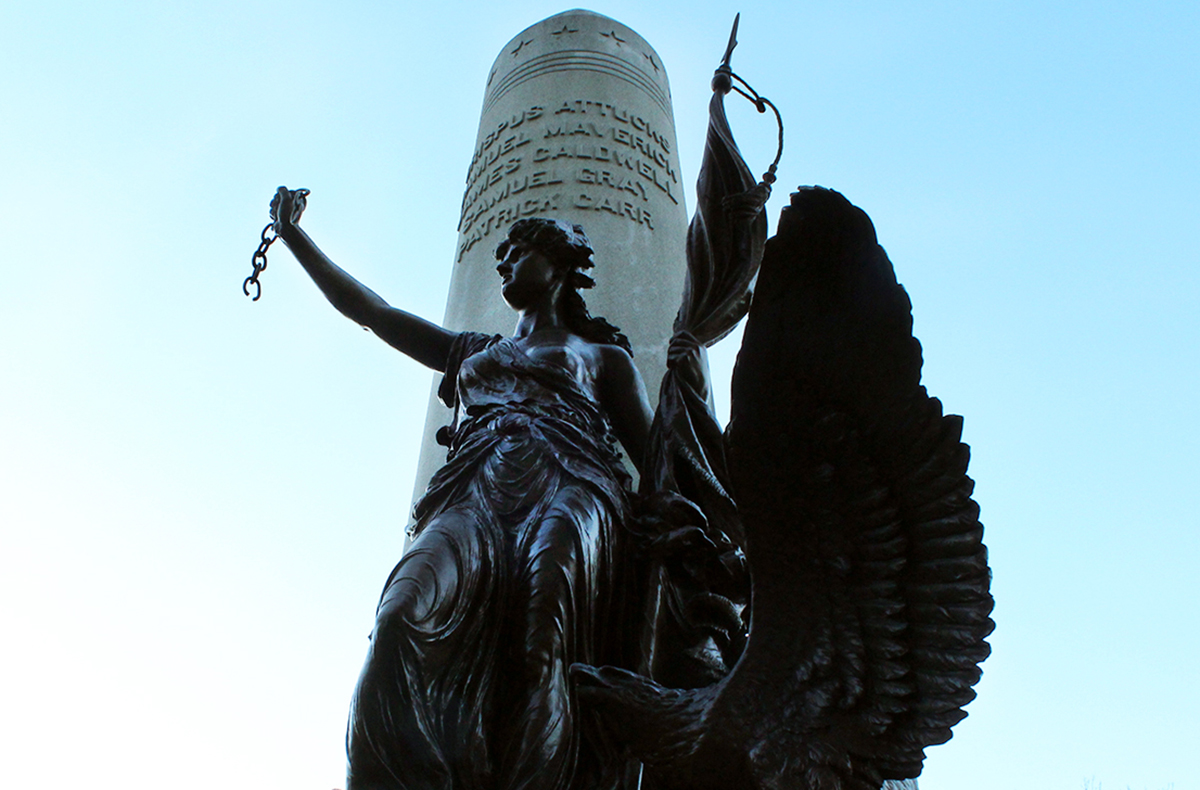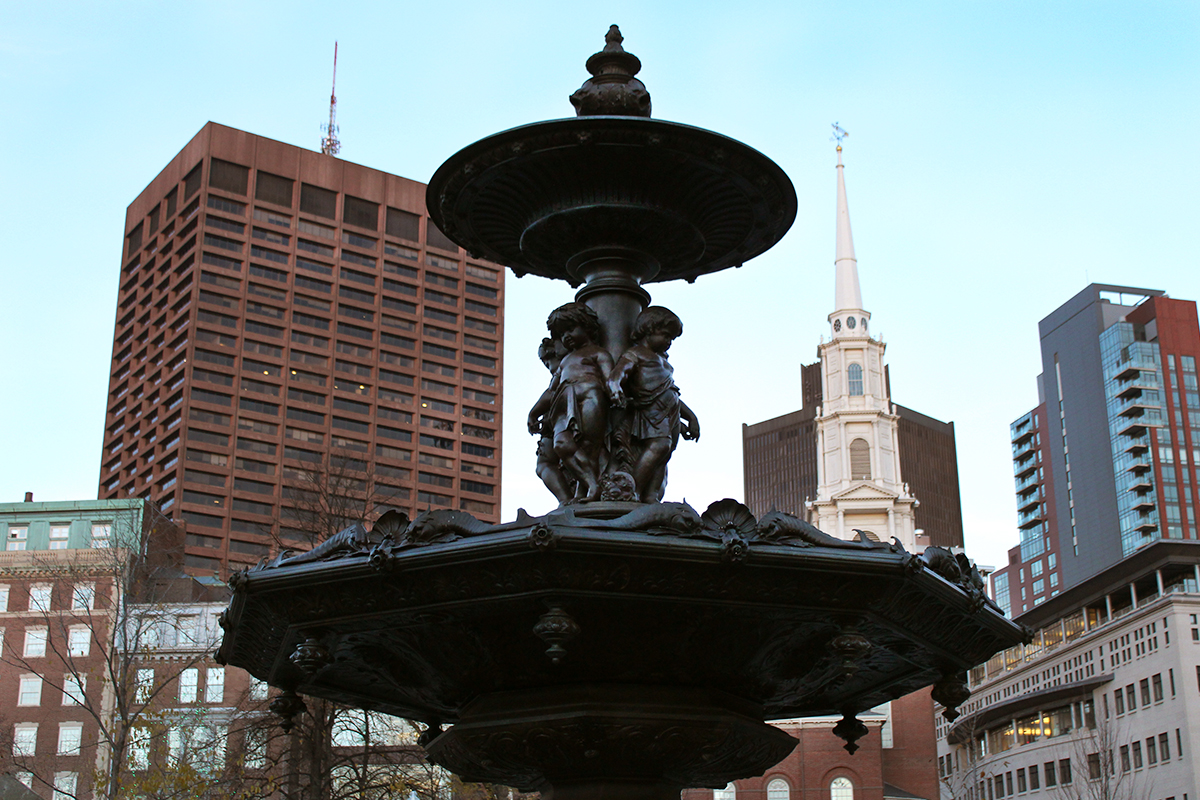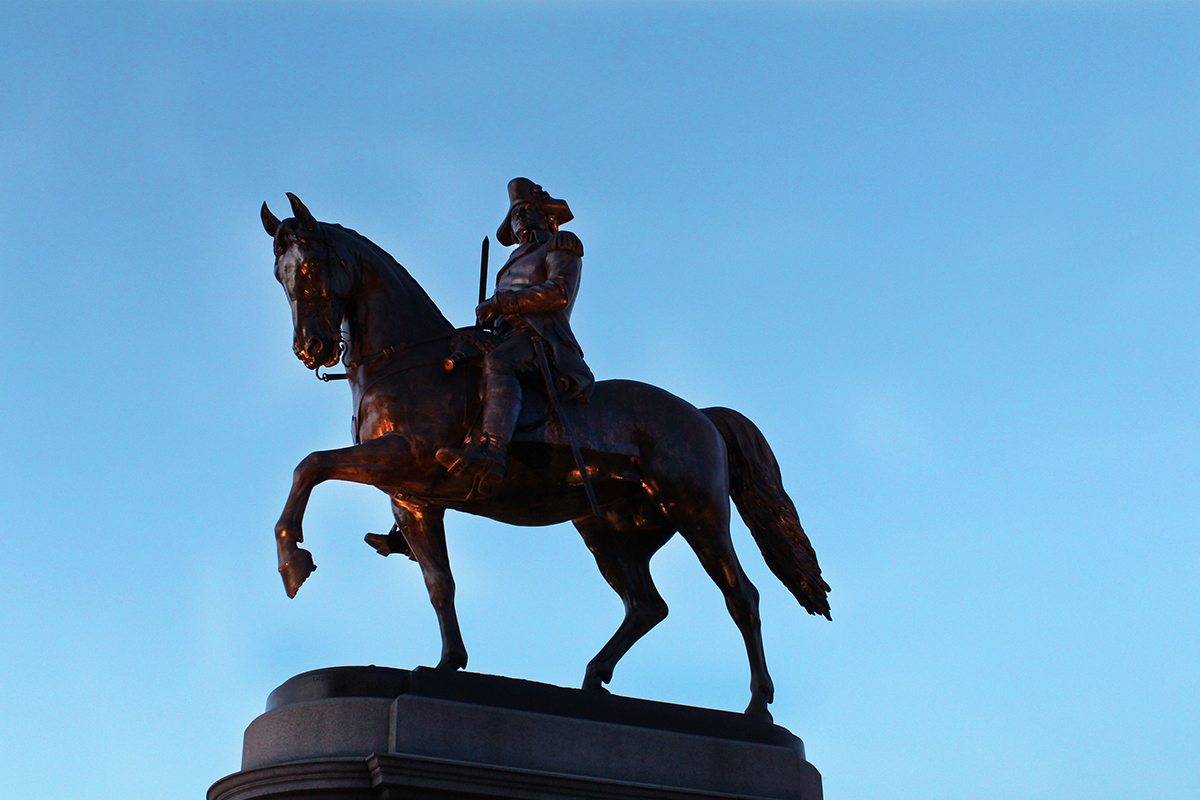Neighborhood Public Art: Boston Common and Public Garden

Photo by Anna Buckley
The Boston Common and the Public Garden bustle with activity during any season. But when the sun sets and the visitors head home, there’s a pack of people who stick around—permanently—commemorated in Boston’s oldest figureheads and figurative bronze reliefs.
The multitude of statues and sculptures downtown represent values and beliefs held by Bostonians for hundreds of years. Maybe a memoriam in bronze of Good Will Hunting actor and beloved late comedian Robin Williams will be next to join the motley crew.
Below are a few of the most famous statues in the area:

Photo by Anna Buckley
Boston Massacre / Crispus Attucks Monument
Honoring the victims of the 1770 Boston Massacre, this monument features a statue of the Spirit of the Revolution holding a broken chain and crushing the British monarchy under her foot, while an eagle takes flight beside her. The names of the five men who were murdered that day (Crispus Attucks, James Caldwell, Patrick Carr, Samuel Gray and Samuel Maverick) are memorialized in stone above her.

Photos by Anna Buckley
Learning, Industry, and Religion Statues
George Francis Parkman, Jr. (1823-1908), the progeny of the ill-fated murder victim Dr. George F. Parkman, commissioned these statues as one of his many contributions to the City of Boston and the Emerald Necklace. Sculptor Adio diBiccari and his brother-in-law Arcangelo Cascieri—uncles of Louis and Michael diBiccari, who own the Tavern Road restaurant in Fort Point—created these three figures, which represent Boston’s intellectual, spiritual, and industrial energy. The personification of Learning cradles a book, Industry makes use of a jackhammer, and Religion kneels, palms outward, in prayer.

Photo by Anna Buckley
The Brewer Fountain
Nearly 150 years old, this fountain had seen better days before its massive renovation and restoration back in 2010. The fountain, which is believed to be the only remaining copy of the original featured at the 1855 Paris World Fair, was imported from Switzerland by a wealthy merchant named Gardner Brewer, who had the work of art placed on the Common in line of sight of his Beacon Hill home.

Photo by Anna Buckley
Memorial to Robert Gould Shaw and the 54th Regiment
This bronze relief sculpture, created by Augustus Saint-Gaudens and unveiled in 1897, stands at the edge of the Boston Common. Depicted is the 54th Regiment Massachusetts Volunteer Infantry—one of the first official African-American units in the United States during the Civil War—on March 28, 1863, the day that they marched down Beacon Street, off to battle, amidst grand fanfare.

Photo by Anna Buckley
Founders Memorial
This piece, which was commissioned in 1930 for the 300th anniversary of Boston’s founding, depicts William Blackstone greeting Colonial governor John Winthrop and his company, who have just disembarked from the Arabella.

Photo by Anna Buckley
Edward Everett Hale Statue
Beside the central Charles Street gate of the Public Garden stands author Edward Everett Hale, known best for his allegorical story “The Man Without a Country” (1863), which is about the American Civil War—and intended to promote the Unionist cause.

Photo by Anna Buckley
Make Way for Ducklings
Brought about in honor of Robert McCloskey’s 1941 bestseller Make Way for Ducklings, these bronze quackers created by sculptor Nancy Schön depict Mrs. Mallard and her eight ducklings as they waddle their way over to the Garden’s lagoon. These dillydallying ducks have been a longtime favorite of Bostonians and visitors alike since their unveiling in 1987.

Photo by Anna Buckley
Ether Fountain
The oldest monument in the Public Garden, the Ether Fountain, was donated by Boston resident and merchant Thomas Lee in 1868. Lee initially contacted the Boston City Government, proposing “to erect and present to the city a monument in the form of a fountain, as an expression of gratitude for the relief of human suffering occasioned by the discovery of the anesthetic properties of sulphuric ether.” The first operation using anesthetic took place at Massachusetts General Hospital in 1846.

Photo by Anna Buckley
George Washington Sculpture
Following the Ether Fountain, the George Washington sculpture was erected in 1869. The local collaboration on this piece became a source of significant pride for Bostonians, seeing as Thomas Ball, a poor Charlestown boy, had sculpted the statue, Boston masons had raised the massive granite base, and a Massachusetts foundry had cast the statue.

Photo by Anna Buckley
William Ellery Channing Statue
Forever poised on the corner of Boylston and Arlington, William Ellery Channing stands beneath an elaborately carved marble structure. As the foremost Unitarian preacher in the U.S. in the early 1800s, Channing was known for his impassioned sermons and liberal theology.

Photo by Anna Buckley
Charles Sumner Statue
As a Boston-bred politician and Massachusetts senator, Charles Sumner was a staunch anti-slavery advocate. His statue was raised in 1878 and created by Thomas Ball.

Photo by Anna Buckley
Thomas Cass Statue
Born in Ireland, Thomas Cass’ parents moved the family to the North End of Boston, and Cass later founded and commanded the 9th Regiment Massachusetts Volunteer Infantry of the Union Army. Cass was wounded at the Battle of Malvern Hill in 1862, and he died soon after from his battle wounds after returning to Boston.

Photo by Anna Buckley
Tadeusz Kosciuszko Statue
Born in the Polish-Lithuanian Commonwealth in 1746, Tadeusz Kosciuszko became a trusted aid to George Washington in the War for Independence. As a close friend of Thomas Jefferson, he shared ideals of human rights and was sympathetic to the American cause, and thus, he sailed for America in June 1776, submitted an application to the United States Congress, and was assigned to the United States War Department the next day.

Photo by Anna Buckley
Wendell Phillips Statue
Born in Boston in 1811, Wendell Phillips was an American abolitionist, orator, and lawyer, best remembered for his activism for women’s and Native Americans’ rights.

Photo by Anna Buckley
Edgar Allan Poe Statue
At the corner of Boylston Street and Charles Street South, Edgar Allan Poe can be seen heading home—with a massive raven at his side, naturally. Artist Stefanie Rocknak designed the life-sized statue, while the Edgar Allan Poe Foundation of Boston funded the statue to honor the writer’s birthplace. The piece was dedicated in October of 2014.
Plan your own tour of the artworks with our map:


